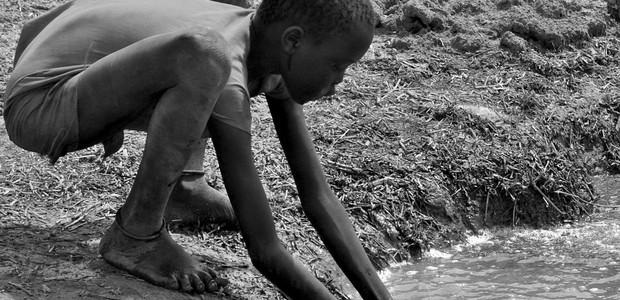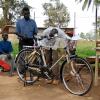Health Expert CommentaryIt’s time to shrink South Sudan’s long list of preventable diseases

There are signs that South Sudan is on track to eliminate Guinea Worm, a parasite which spreads to humans when they drink water infected with the larvae. The painful illness, where a worm grows inside the body and crawls out through the skin, has long affected South Sudanese, but no new cases have been reported since November 2014.
It is time to launch an ambitious strategy to eradicate at least five additional NTDs from the country.
This welcome development suggests that it is possible to eliminate Neglected Tropical Diseases (NTDs) in South Sudan. As South Sudan is about to celebrate the fifth year of independence, it is time to launch an ambitious strategy to eradicate at least five additional NTDs from the country.
Neglected Tropical Diseases are a group of 17 infections, identified by the World Health Organization (WHO) to be caused by parasitic worms, protozoa and bacteria, and affecting the worlds poorest and most vulnerable. These infections include Guinea Worm, Onchocerciasis (or River Blindness), Loiasis (or African eye-worm), Leprosy, Human African Trypanosomiasis (sleeping sickness) and many others.
South Sudan is thought to have one of the highest rates of such neglected tropical diseases worldwide. It has 12 of the 17 known infections. It also has Nodding Syndrome, a little-known disease which emerged in Sudan in the 1960s. It is a mentally and physically disabling condition that only affects children. It is not on the WHO list of Neglected Tropical Diseases.
In April 2014, global funding commitments for NTDs reached US$ 240 million, showing international support for the WHO’s goal to eliminate NTDs by 2020. Meanwhile, pharmaceutical companies increased drug donations, making preventive therapy through mass drug administration feasible and cost-effective.
The Ministry of Health, Republic of South Sudan recently re-affirmed its commitment to end NTDs in South Sudan by 2020, in line with these global resolutions. A feasible and cost-effective strategy for the elimination, eradication and control of the major NTDs in South Sudan, and building on the successes of the South Sudan Guinea Worm Eradication Program (SSGWEP) is therefore, well within sight.
Among the top priorities are two infections that are preventable and which cause blindness – Trachoma and Onchocerciasis (River Blindness).
Trachoma is a leading cause of blindness in South Sudan, affecting approximately 1.5 million people, with an estimated 3.9 million in need of antibiotic treatment. Trachoma, caused by the bacterium Chlamydia Trachomatis, is spread through contact with eye discharge from infected persons, or through transmission by eye-seeking flies.
The WHO Alliance for Global Elimination of Blinding by the year 2020, recommends the what it calls a SAFE strategy for elimination and control of Trachoma, which involves surgery to correct Trichiasis, Antibiotics for treatment of active Trachoma (Azithromycin or Tetracycline eye ointment), facial cleanliness as a preventive measure against transmission, and environmental improvements, particularly increasing access to safe water and improved sanitation.
Eliminating preventable blindness by prioritising treatment with Azithromycin (or Tetracycline) will reduce the number of people with eye-discharge, and therefore the spread of the disease via eye-seeking flies. Azithromycin is donated by Pfizer, through the International Trachoma Initiative.
Onchocerciasis is the second cause of blindness and is endemic in all of South Sudan. It is caused by infection through a parasite and is transmitted through the bite of black flies. Treatment of Onchocerciasis is with Mectizan/Ivermectin, donated by Merck & Co.
Another urgent disease to tackle is Loiasis (African Eye-Worm), which is caused by the parasitic worm, Loa Loa. It causes eye congestion, itching, pain, and light sensitivity, but does not lead to blindness. The presence of the Loa Loa infection in places that also have Onchocerciasis, complicates the mass treatment of Onchoceriasis with Ivermectin, as this increases the risk of severe adverse effects. This necessitates a programme of dual control of both Onchocerciasis and Loiasis, in South Sudan. Treatment of Loiasis is with Diethyl Carbamazine Citrate (DEC), which is available as a donation from Eisai Co. Ltd. through WHO, for the period 2013–2020.
Other diseases include:
Lymphatic Filiariasis
Lymphatic Filariasis (Elephantiasis) is caused by infection with mosquito-borne, parasitic worm of the genera Wuchereria and Brugia. It is typically acquired in childhood but manifests itself in adulthood, where it leads to either temporary or permanent disability in a section of infected people. The WHO Global Program to Eliminate Lymphatic Filariasis (GPELF) outlines two key strategies; single annual doses of Diethyl-Carbamazine Citrate (DEC) or Ivermectin plus Albendazole to the entire eligible population living in areas where the disease is endemic. MoH-RSS recommends treatment with Ivermectin plus Albendazole. Albendazole is donated by GlaxoSmithKline.
Soil Transmitted Helminthes (STHs)
Soil Transmitted Helminthes (STHs) are common intestinal worms transmitted by eggs excreted in human faeces or urine which contaminate the soil and water sources in areas that lack adequate sanitation. Recommended treatment is by population-based chemotherapy, especially targeting school children using Albendazole (ABL) and Mebendazole two times annually.
Schistosomiasis (SCH)
Schistosomiasis (SCH), also known as bilharzia, is a water-borne disease mainly caused by two species of blood flukes (called schistosomes). Transmission is through contact with contaminated fresh water (lakes and ponds, rivers, dams) and recommended treatment is annual chemotherapy using Praziquantel for school age children. Praziquantel is available as a donation from Merck KGaA, through WHO.
This article is a call to arms to the Ministry of Health, Republic of South Sudan. Plant the seed that gives people the gift of sight!
South Sudan has achieved much in this direction in the five years since independence. However, a lot more remains to be done. An ambitious goal to eliminate neglected tropical diseases by the country’s tenth year of independence is feasible and achievable only if the people of South Sudan are committed to reducing deaths among the most vulnerable populations.
This article is a call to arms to the Ministry of Health, Republic of South Sudan. Plant the seed that gives people the gift of sight!


